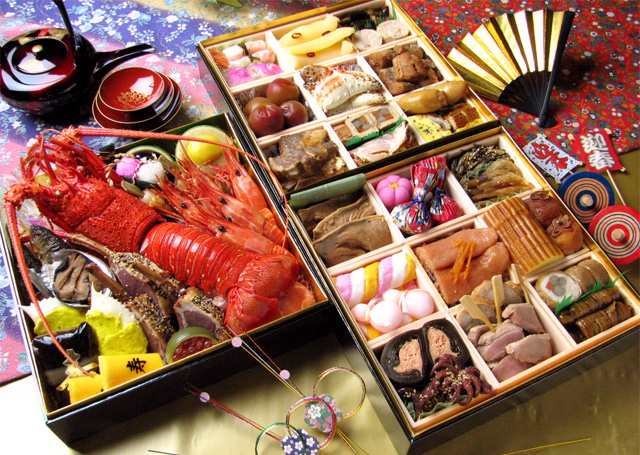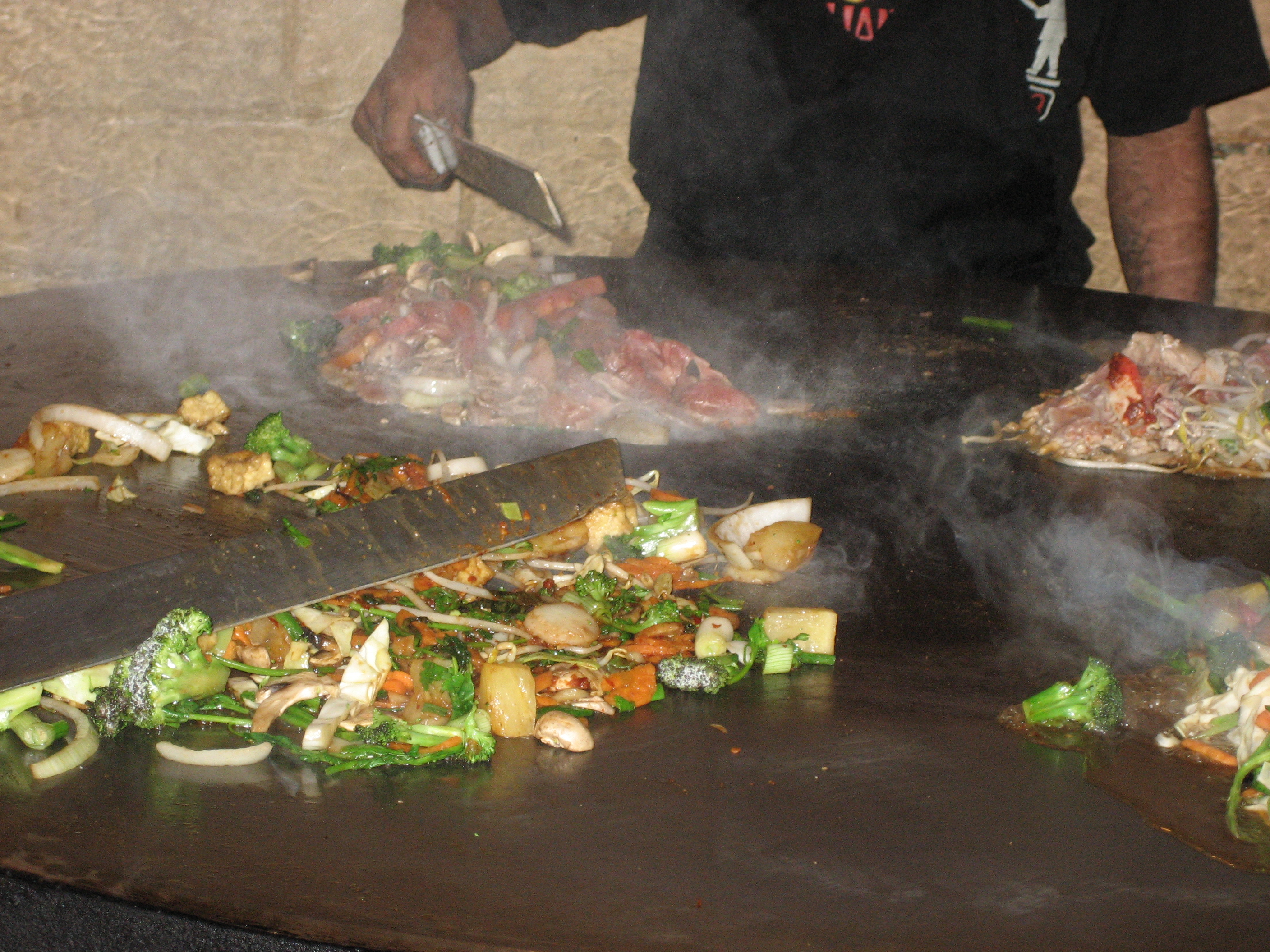|
Jingisukan
is a Japanese grilled mutton dish prepared on a convex metal skillet or other grill. It is often cooked alongside beansprouts, onions, mushrooms, and bell peppers, and served with a sauce based in either soy sauce or sake. The dish is particularly popular on the northern island of Hokkaidō and in China. History Jingisukan, originating from the Japanese transliteration of Genghis Khan, refers to a style of grilling mutton, which is also referred to as a type of yakiniku. The dish was conceived in Hokkaidō, where it has been a popular blue-collar dish that has only recently gained nationwide popularity. The name Jingisukan is thought to have been invented by Sapporo-born Tokuzo Komai, who was inspired by the grilled mutton dishes of Northeastern Chinese cuisine. The first written mention of the dish under this name was in 1931. In 1918, according to the plan by the Japanese government to increase the flock to one million sheep, five sheep farms were established in Japan. Howe ... [...More Info...] [...Related Items...] OR: [Wikipedia] [Google] [Baidu] |
Yakiniku
, meaning "grilling, grilled meat", is a Japanese language, Japanese term that, in its broadest sense, refers to grilled meat cuisine. Today, "yakiniku" commonly refers to a style of cooking bite-size meat (usually beef and offal) and vegetables on Gridiron (cooking), gridirons or griddles over a flame of wood charcoals carbonized by dry distillation (''sumibi'', 炭火) or a gas or electric grill. It is one of the most popular Dish (food), dishes in Japan. The origin of contemporary yakiniku is considered to be Korean barbecue, one of the most popular dishes in Korean cuisine. "Yakiniku" originally referred to western "barbecue" food, the term being popularized by Japanese writer Kanagaki Robun (仮名垣魯文) in his ''Seiyo Ryoritsu'' (i.e. "western food handbook") in 1872 (Meiji period). The term later became associated with Korean-derived cuisine (Korean barbecue) during the early Shōwa period. Due to the Korean War, the terms associated with Korea in Japan were divided i ... [...More Info...] [...Related Items...] OR: [Wikipedia] [Google] [Baidu] |
Mutton
Lamb and mutton, collectively sheep meat (or sheepmeat) is one of the most common meats around the world, taken from the domestic sheep, ''Ovis aries'', and generally divided into lamb, from sheep in their first year, hogget, from sheep in their second, and mutton, from older sheep. Generally, "hogget" and "sheep meat" aren't used by consumers outside Norway, New Zealand, South Africa, Scotland, and Australia. Hogget has become more common in England, particularly in the North (Lancashire and Yorkshire) often in association with rare breed and organic farming. In South Asian and Caribbean cuisine, "mutton" often means goat meat.''Oxford English Dictionary'', 3rd edition, June 2003Italian, make similar or even more detailed distinctions among sheep meats by age and sometimes by sex and diet—for example, ''lechazo'' in Spanish refers to meat from milk-fed (unweaned) lambs. Classifications and nomenclature The definitions for lamb, hogget and mutton vary considerably between ... [...More Info...] [...Related Items...] OR: [Wikipedia] [Google] [Baidu] |
Tōno, Iwate
is a Cities of Japan, city in Iwate Prefecture, Japan. , the city had an estimated population of 26,378, and a population density of 31.6 persons per km2 in 10,759 households. The total area of the city is . Tōno is known as "The City of Folklore" for its rural nature, its preservation of traditional culture and especially for the collection of folktales, ''Tōno Monogatari,'' written by Kunio Yanagita in 1910. Geography Tōno is located in central Iwate Prefecture, in the floodplain of the Sarugaishi River, surrounded by a ring of mountains. Mount Hayachine sits at the northernmost point of the city where Hanamaki, Kawai and Tōno meet. At 1,914 meters it is also the city's highest point. Mt. Rokkoushi, (1,294 meters) dominates the landscape to the east and Mt. Ishigami (1,038 meters) is the highest mountain in the west. Together these peaks form Tōno's "big three" mountains. The highest points in southern Tōno are Mt. Sadato (884 meters) on the border of Sumida and Mt. Tane ... [...More Info...] [...Related Items...] OR: [Wikipedia] [Google] [Baidu] |
Japanese Cuisine
Japanese cuisine encompasses the regional and traditional foods of Japan, which have developed through centuries of political, economic, and social changes. The traditional cuisine of Japan (Japanese language, Japanese: ) is based on rice with miso soup and other dishes with an emphasis on seasonal ingredients. Side dishes often consist of fish, Tsukemono, pickled vegetables, tamagoyaki, and vegetables cooked in broth. Common seafood is often grilled, but it is also sometimes served raw as sashimi or as sushi. Seafood and vegetables are also deep-fried in a light batter, as '. Apart from rice, a staple includes noodles, such as soba and udon. Japan also has many simmered dishes, such as fish products in broth called , or beef in and . Historically influenced by Chinese cuisine, Japanese cuisine has also opened up to influence from European cuisine, Western cuisines in the modern era. Dishes inspired by foreign food—in particular Chinese food—like ramen and , as well as foods ... [...More Info...] [...Related Items...] OR: [Wikipedia] [Google] [Baidu] |
Teppanyaki
, often called in the United States and Canada, is a post-World War II style of Japanese cuisine that uses an iron griddle to cook food. The word is derived from , the metal plate on which it is cooked, and , which means grilled, broiled, or pan-fried. In Japan, refers to dishes cooked using a , including steak, shrimp, , , and . are typically propane-heated, flat-surfaced, and are widely used to cook food in front of guests at restaurants. They are commonly confused with the barbecue grill, which is called in Japanese, and has a charcoal or gas flame and is made with an open grate design. With a solid griddle-type cook surface, the is capable of cooking small or semisolid ingredients such as rice, egg and finely chopped vegetables. Origin The originator of the -style steakhouse is believed to be Shigeji Fujioka of the Japanese restaurant chain Misono. The restaurant claims to be the first to introduce the concept of cooking Western-influenced food on a in Japan, in 1 ... [...More Info...] [...Related Items...] OR: [Wikipedia] [Google] [Baidu] |
Mongolian Barbecue
Mongolian barbecue () is a method of preparing Stir frying, stir-fried noodle dishes. Despite its name, the dish is not Mongolian cuisine, Mongolian, nor was it influenced by Mongolian cuisine. It was developed in Taiwan by a waishengren during the 1950s. Furthermore, it is also unrelated to actual barbecue traditions (such as American barbecue, American or Korean barbecue), since it is not cooked on a perforated grill above the smoke of an open flame, but rather a specialized flatiron grill. The kind of grill used to cook it is in the shape of a circle, and an upside-down wok was, in 1979, used to cook the dish in Taiwanese establishments. It has more in common with Teppanyaki. Origin Mongolian barbecue was created by Taiwanese comedian and restaurateur Wu Zhaonan, who fled to Taiwan after the outbreak of the Chinese Civil War, and opened a street food stall in , Downtown Taipei in 1951. While he initially wished to name the dish "Peking barbecue" after his hometown, due to p ... [...More Info...] [...Related Items...] OR: [Wikipedia] [Google] [Baidu] |
List Of Lamb Dishes
This is a list of the popular lamb and mutton dishes and foods worldwide. Lamb and mutton are terms for the meat of domestic sheep (species ''Ovis aries'') at different ages. A sheep in its first year is called a lamb, and its meat is also called lamb. The meat of a juvenile sheep older than one year is hogget; outside North America this is also a term for the living animal. The meat of an adult sheep is mutton, a term only used for the meat, not the living animal. Meat from sheep features prominently in several cuisines of the Mediterranean cuisine, Mediterranean. Lamb and mutton are very popular in Central Asian Cuisine, Central Asia and in Indian cuisine, India, where other red meats may be eschewed for religious or economic reasons. It is also very popular in Cuisine of Australia, Australia. Barbecued mutton is also a specialty in some areas of the United States of America, United States (chiefly Owensboro, Kentucky) and Canada. Lamb dishes * Abbacchio – Italy * ... [...More Info...] [...Related Items...] OR: [Wikipedia] [Google] [Baidu] |
Shibetsu, Hokkaido
270px, downtown Shibetsu is a city located in Kamikawa Subprefecture, Hokkaido, Japan. , the city had an estimated population of 16,400 in 706 households, and a population density of 15 people per km2. The total area of the city is . Geography Shibetsu is located N of Asahikawa and NNE of Sapporo. It is situated by the Shibetsu River in the north and its valley. The name comes from the Ainu word for "great river". The city center is located in the southern part of the Nayoro Basin, near the confluence of the Teshio River and the Kenbuchi River. The eastern part of the city is in the Kitami Mountains, while the Onnebetsu area in the west is mountainous land that continues into the Teshio Mountains. Lake Iwaonai, located in the eastern part of the city, is the uppermost reaches of the Teshio River. Neighbouring municipalities * Hokkaido ** Nayoro ** Wassamu ** Kenbuchi ** Shimokawa ** Pippu ** Kamikawa ** Aibetsu ** Horokanai ** Takinoue Climate Shibetsu has ... [...More Info...] [...Related Items...] OR: [Wikipedia] [Google] [Baidu] |
Thailand
Thailand, officially the Kingdom of Thailand and historically known as Siam (the official name until 1939), is a country in Southeast Asia on the Mainland Southeast Asia, Indochinese Peninsula. With a population of almost 66 million, it spans . Thailand Template:Borders of Thailand, is bordered to the northwest by Myanmar, to the northeast and east by Laos, to the southeast by Cambodia, to the south by the Gulf of Thailand and Malaysia, and to the southwest by the Andaman Sea; it also shares maritime borders with Vietnam to the southeast and Indonesia and India to the southwest. Bangkok is the state capital and List of municipalities in Thailand#Largest cities by urban population, largest city. Tai peoples, Thai peoples migrated from southwestern China to mainland Southeast Asia from the 6th to 11th centuries. Greater India, Indianised kingdoms such as the Mon kingdoms, Mon, Khmer Empire, and Monarchies of Malaysia, Malay states ruled the region, competing with Thai states s ... [...More Info...] [...Related Items...] OR: [Wikipedia] [Google] [Baidu] |
Tokyo
Tokyo, officially the Tokyo Metropolis, is the capital of Japan, capital and List of cities in Japan, most populous city in Japan. With a population of over 14 million in the city proper in 2023, it is List of largest cities, one of the most populous urban areas in the world. The Greater Tokyo Area, which includes Tokyo and parts of six neighboring Prefectures of Japan, prefectures, is the most populous metropolitan area in the world, with 41 million residents . Lying at the head of Tokyo Bay, Tokyo is part of the Kantō region, on the central coast of Honshu, Japan's largest island. It is Japan's economic center and the seat of the Government of Japan, Japanese government and the Emperor of Japan. The Tokyo Metropolitan Government administers Tokyo's central Special wards of Tokyo, 23 special wards, which formerly made up Tokyo City; various commuter towns and suburbs in Western Tokyo, its western area; and two outlying island chains, the Tokyo Islands. Although most of the w ... [...More Info...] [...Related Items...] OR: [Wikipedia] [Google] [Baidu] |








